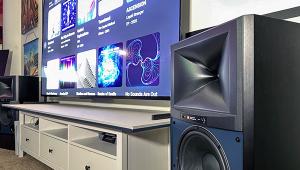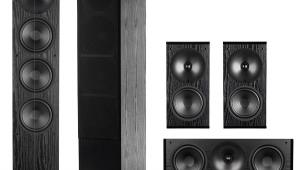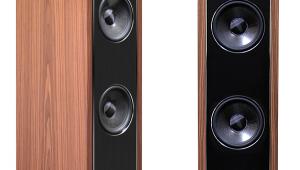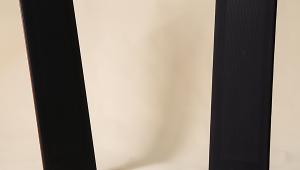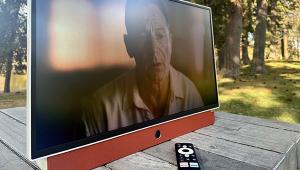The Revel Concerta F12 Surround Sound Speaker System Measurements
All measurements on the F12 and C12 were made with the grilles removed. The grille actually made little measured difference in the response of the F12, but a bit more in the C12 (a dip of about 2-3dB in the 3-4kHz region).
The impedance of the F12 is typical of a ported enclosure tuned to approximately 33Hz, with a minimum impedance of 3.7Ω at 2.5kHz (4.9Ω at 127Hz, with only a small capacitive phase angle at this frequency). I would rate the speaker's nominal impedance, conservatively, at 6Ω. The speaker's sensitivity is approximately 89dB/2.83V/m, and it should be an easy load for any reasonably well-designed amplifier or AV receiver, though I believe it would be reasonably comfortable driving a 4Ω load.
The horizontal front response of the F12 is shown in Fig.1 (violet). This is the pseudo-anechoic response averaged over a 30° forward horizontal angle, taken at tweeter height, combined with the nearfield responses of the woofers and port.

Fig.1: Revel F12, pseudo-anechoic response off the horizontal axis at 45° (red) and 60° (blue).
This ±15° averaged front horizontal response is very smooth, excepting only mild peaks at about 3.2kHz and 8.5kHz. The horizontal off-axis response tracks the on-axis result fairly closely, apart from the expected rolloff at higher frequencies. The only significant deviation is some emphasis just above 3kHz, which is just barely visible in the on-axis response. The effective lower limit of the bass (-10dB) is at 30Hz.
Fig.2 shows the same averaged horizontal front response (purple), this time overlaid with the vertical responses taken at +15° (red) and –15° (blue). These curves suggest that your vertical ear position relative to the tweeter, within reason, will not be particularly critical with this speaker.

Fig.2: Revel F12, pseudo-anechoic response at 15° above (red) and 15° below (blue) the tweeter axis.
The Revel C12's sealed cabinet is tuned to about 66Hz. Its minimum impedance measured 3.9Ω at 921Hz (4.5Ω at 132Hz, with a low capacitance phase angle). I would rate its nominal impedance very conservatively, at 5Ω. Its sensitivity measured approximately 89dB/2.83V/m, and like the F12, it should be an easy load to drive as long as your amp or receiver is tolerant of a 4Ω load.
The measured front horizontal response of the C12, taken on the tweeter axis and averaged in the same manner as described above for the F12 (but no port here), is shown in Fig.3 (violet curve). The effective bass extension is approximately 51Hz (-10dB). The on-axis response is very smooth and flat, and the off-axis response shows only a shallow dip centered at roughly 600Hz from interference between the two woofers. No interference is visible off-axis between the vertically oriented midrange and tweeter.

Fig.3: Revel C12, pseudo-anechoic response off the horizontal axis at 45° (red) and 60° (blue).
Fig.4 shows the vertical response of the C12 at + 15° (red) and –15° (blue), overlaid again with the averaged front horizontal response. The +15° result shows a sharp dip centered at about 2kHz. The –15° result is smoother and very close to the on-axis response—appropriate for a speaker that will typically be mounted above ear height atop a big screen TV. If you position the speaker below the screen, you might want to tilt it upwards—or consider mounting it upside down, with the midrange on top!
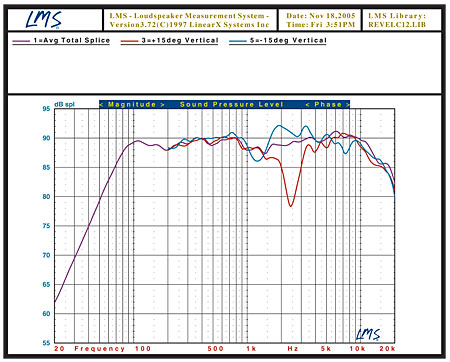
Fig.4: Revel C12, pseudo-anechoic response at 15° above (red) and 15° below (blue) the tweeter axis.
The F12 and C12 are exceptionally well engineered speakers, and they do measure better than the Infinity Beta designs MF reviewed several months ago, easily justifying their higher price.—Thomas J. Norton
All figures: Violet curve: pseudo-anechoic response on tweeter axis, averaged across a 30° horizontal window, combined with nearfield responses of the woofers (and, in the F12, the port) response. All measurements taken at 1-meter.
- Log in or register to post comments




